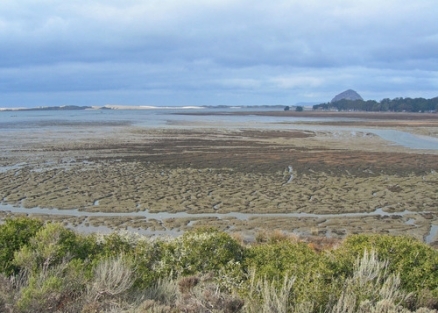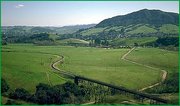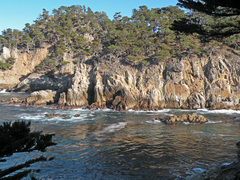Central California Coast
The Central California Coast section consists of mountains, hills, valleys, and plains in the Santa Lucia Range of California in the USA. This region is bounded on the west by the Pacific Ocean, so that the climate exhibits an appreciable marine influence. The subsection is mostly within Major Land Resource Area (MRLA) 14 and partly in MLRA 4 and 15. MLRA units boundaries are defined by the U.S. Natural Resources Conservation Service. The Central California Coast section is divided into 12 subsections.
Contents
Geomorphology and Lithology
Parallel ranges and valleys on folded, faulted and metamorphosed strata; rounded crests of subequal height. Coast Ranges geomorphic province. Elevations of this region range from sea level to 3800 feet. Cenozoic marine and nonmarine sedimentary rocks and alluvial deposits, and Mesozoic granitic and ultramafic rocks.
Soil Taxa
Soil types occurring here include Alfisols, Entisols, Inceptisols, Mollisols, Ultisols and Vertisols in combination with isomesic, mesic or thermic soil temperature regimes and xeric, udic, ustic or aquic soil moisture regimes.
Vegetation
Predominant potential natural plant communities include the Blue oak series, Purple needlegrass series, Coast live oak series, Chamise series, Valley oak series, Redwood series, Douglas-fir - tanoak series and California sagebrush series. There are also specialized plant communities on the Central California Coast, such as the Monterey Cypress forests which occur in only two locations on Earth, both on the Central Coast.
The following series are found throughout the section and are not restricted to or extensive in any subsection. Series dominated by exotic plants are not listed under subsections unless they are extensive and stable.
- Series dominated by alien plants: Broom series, California annual grassland series, Cheatgrass series, Eucalyptus series, Giant reed series, Iceplant series, Pampas grass series.
- Series that can occur in all subsections, but are not extensive: Beaked sedge series, Black cottonwood series, Bulrush series, Bulrush - cattail series, Cattail series, California oatgrass series, Creeping ryegrass series, Duckweed series, Foothill needlegrass series, Mexican elderberry series, Mosquito fern series, Nodding needlegrass series, One-sided bluegrass series, Pondweeds with floating leaves series, Pondweeds with submerged leaves series, Purple needlegrass series, Saltgrass series, Sedge series and Spikerush series.
- Series restricted to riparian settings: Arroyo willow series, Buttonbush series, California sycamore series, Fremont cottonwood series, Mixed willow series, Mulefat series, Narrowleaf willow series, Red willow series, Sitka willow series, White alder series.
Fauna
Mammals include mule deer, bobcat, weasel, fox, skunk, opossum and ground squirrel; there are also significant marine mammals that breed on land including the Northern elephant seal. Turkey vultures, hawks, owls, herons, egrets, flycatchers, swallows and ravens are common birds. Birds of concern include the brown pelican, lesser tern, osprey, black rail, clapper rail, marbled murrelet, spotted owl and bank swallow. Reptiles and amphibians include the western rattlesnake, common and western aquatic garter snakes, northern and southern alligator lizards and several species of salamanders and frogs. Marine and shore species include sea otter, sea lions, seals, brown pelicans, gulls, cormorants, terns and various shorebirds. Alien species include small populations of fallow deer and barbary sheep. Feral pigs are common throughout large portions of the section.
Climate and Growing Season
Annual precipitation has a wide variance within the Central California Coast, ranging from 12 to 60 inches per annum. Maximum daytime temperatures typically range from 45 to 75 degrees Fahrenheit. Summer daytime temperatures are often modified by morning fog and sea breezes. The agricultural growing season varies between 200 to 300 days, depending upon latitude and distance to the Pacific Ocean.
Surface Water Characteristics
Several slow moving, tide affected major rivers in alluvial channels terminate in Monterey Bay discharge to the Pacific in purely coastal watersheds. A few slow moving perennial streams in alluvial or weak bedrock channels flowing directly to the Pacific Ocean occur in the northern part of the area, including the Carmel River. Some fast moving perennial streams in weak bedrock channels flowing directly to the Pacific Ocean occur in the southern part of the area.
Disturbance Regimes
Chief disturbance regimes include fire, seismic events and land use changes.
- Fire: Fires are of variable frequency, season and intensity.
- Seismic Activity: Seismically active area with strong shaking and ground rupture
- Land Use. Composition and successional sequence of some plant communities (especially grassland communities) has changed because of plant and animal species introduced between the late 1700’s and early 1900’s related to grazing, agriculture, forestry and urbanization. The northern part is rather densely urbanized.
Cultural Ecology
Humans have been inhabiting this region for at least 11,000 years, and have been an influential part of the central coast ecology for about 2000 years, thriving on the diversity of habitats from ocean and estuary to forest, and intensively gathering numerous resources. The Spanish established missions throughout the area in the late 1700’s and early 1800’s introducing agriculture and religious and social changes. Contemporary attitudes and beliefs are varied. The economy is diverse, ranging from Monterey Peninsula educational, financial and technological industries to rural agricultural and fishing industries; shipping, tourism and recreation are also important industries.
References
- M.Barbour, B.Pavlik, F.Drysdale & S.Lindstrom. 1993. California’s Changing Landscapes: Diversity and Conservation of California Vegetation. Sacramento: California Native Plant Society. ISBN: 0943460174
- Taylor H. Ricketts. 1999. Terrestrial ecoregions of North America: a conservation assessment. Island Press. 485 pages
- Michael G. Barbour, Todd Keeler-Wolf, Allan A. Schoenherr. 2007. Terrestrial vegetation of California. University of California Press. 712 pages
- C.Michael Hogan. 2008. Morro Creek. The Megalithic Portal. Ed. A.Burnham
- Philip Alexander Munz, David D. Keck. 1973 . A California flora. University of California Press. 1905 pages
| Disclaimer: This article contains information that was originally published by the United States Forest Service. Topic editors and authors for the Encyclopedia of Earth have edited its content and added new information. The use of information from the United States Forest Service should not be construed as support for or endorsement by that organization for any new information added by EoE personnel, or for any editing of the original content. |


